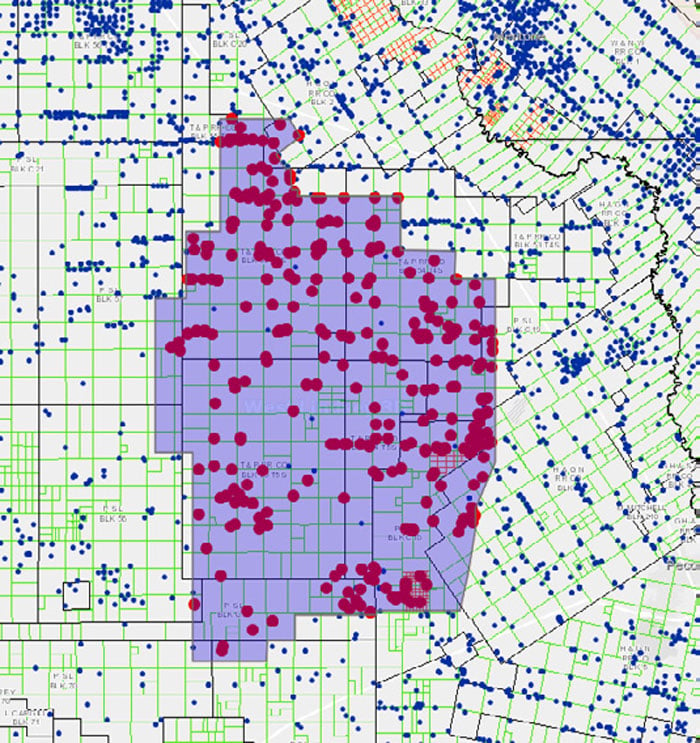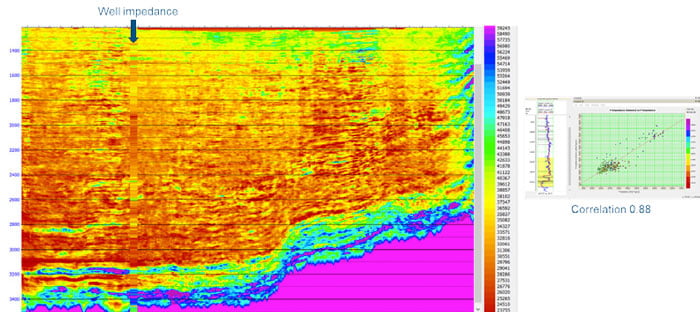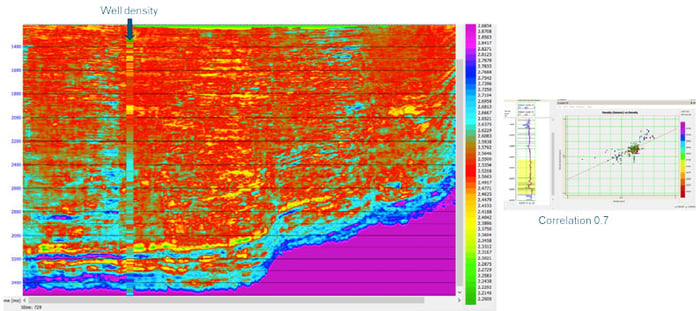When it comes to shale drilling, staying in zone is paramount for any drilling engineer and geosteerer. The higher the percentage of a wellbore “in zone,” the better its performance. Well logs and petrophysical analysis are used to define ideal landing zones to ensure optimum perforation efficiency, fracture initiation, and, most importantly, maximum production. Landing zones can be as thin as 10 ft, which is challenging to navigate in shale wells that often exceed 15,000 ft in measured depth. Enter artificial intelligence (AI).
In recent years, AI, specifically neural networks, has shown great promise to enhance our image of the subsurface. Regarding 3D seismic, AI can generate high-fidelity elastic attributes and rock property estimations in a way traditional inversion cannot. The question is if the improvement in processes and estimates is material enough to lead to better decisions and well results. In this specific instance, the use case is more clearly defining landing zones to help drillers land wells in zone. We investigate this very question using TGS’ own West Lindsey 3D survey in the Delaware Basin (Figure 1) and the TGS ARLAS well database in an AI-based inversion algorithm from Quantico Energy Solutions.
 Fig 1 – West Lindsey 3D survey outline (178 sq. mi.) with TGS well spots
Fig 1 – West Lindsey 3D survey outline (178 sq. mi.) with TGS well spots
Seismic inversion delivers properties such as impedances and elastic moduli in addition to reservoir attributes such as porosities and pore fluid saturations. This helps assess the resource base, define well trajectories, and design hydraulic fracture treatments. Conventional inversion methods may be frequency band limited, and calibration constraints placed on the seismic require additional human interaction for interpretation that introduces potential errors. An AI method, on the other hand, does not have these constraints. In addition, it can increase seismic bandwidth, which is directly proportional to resolution. That means we can discern reservoirs even when their thickness is below seismic resolution. Geosteerers rejoice!
In the West Lindsey survey, ARLAS well logs and a stratigraphic model tied to horizon picks were used in a supervised neural network. Quantico’s well- trained algorithm follows an optimization process to determine how useful each input is in helping model prediction. It is interesting to note that this process does not result in a single “winning” model with the best balance between performance and complexity; instead, a suite of models move information through layers of connected neurons, applying weights and biases at each one to simulate the output. Our output parameters are the above mentioned acoustic impedance, compressional sonic, shear sonic and density.
 In our test case, we used machine learning in both the input data as well as the inversion algorithm. TGS ARLAS well logs provide machine-learning derived log properties for intervals without measurements or log curves that weren’t acquired resulting in a full quad combo with five standard attributes (GR, Neutron Porosity, Density, Resistivity, and p-wave Sonic) for every LAS in 17 unconventional basins in the US, or over 1.5 million wells.
In our test case, we used machine learning in both the input data as well as the inversion algorithm. TGS ARLAS well logs provide machine-learning derived log properties for intervals without measurements or log curves that weren’t acquired resulting in a full quad combo with five standard attributes (GR, Neutron Porosity, Density, Resistivity, and p-wave Sonic) for every LAS in 17 unconventional basins in the US, or over 1.5 million wells.
To make a long story short, we can reach two positive conclusions: 1) the AI inversion confidently predicts properties like p-impedance and density from seismic, and 2) it does so with higher accuracy and faster than traditional methods. This is no easy feat, especially in the Delaware Basin with challenging surface conditions, often reducing the seismic resolution at the reservoir interval, making it harder to define landing zones. Figure 2 shows a cross- section with a log trace inserted at the well location and a cross-plot between the estimated impedance from the seismic and the measured log impedance that correlates very well with the prediction. In fact, the observed correlation coefficient of 0.88 over the zone of interest is very challenging to achieve using a conventional inversion.
 Fig 2 – Seismic p-impedance with log impedance.
Fig 2 – Seismic p-impedance with log impedance.
Figure 3 shows AI derived density as a second predicted attribute with the well density log inserted. The correlation between the density from seismic and the measured density at the well over the zone of interest is 0.7. This is excellent; it is very difficult to nearly impossible to predict density from seismic data using conventional methods.
 Fig 3 – Seismic density with log density
Fig 3 – Seismic density with log density
The implications of the results are quite remarkable. Artificial Intelligence can help us image the subsurface at an unprecedented resolution producing a supercharged high-resolution earth model. We can, therefore, answer the question we investigated very clearly and affirmatively. The use of AI on 3D seismic leads to more clearly defined landing zones enabling drillers to improve lateral wellbore trajectories. In turn, this results in better fracture initiation, optimized frac design, and higher productivity. These are real results with a meaningful impact because they lower the overall risk in reserve calculations and asset valuations. In the current commodity price environment, this could be the difference between slim profitability and substantial loss.


